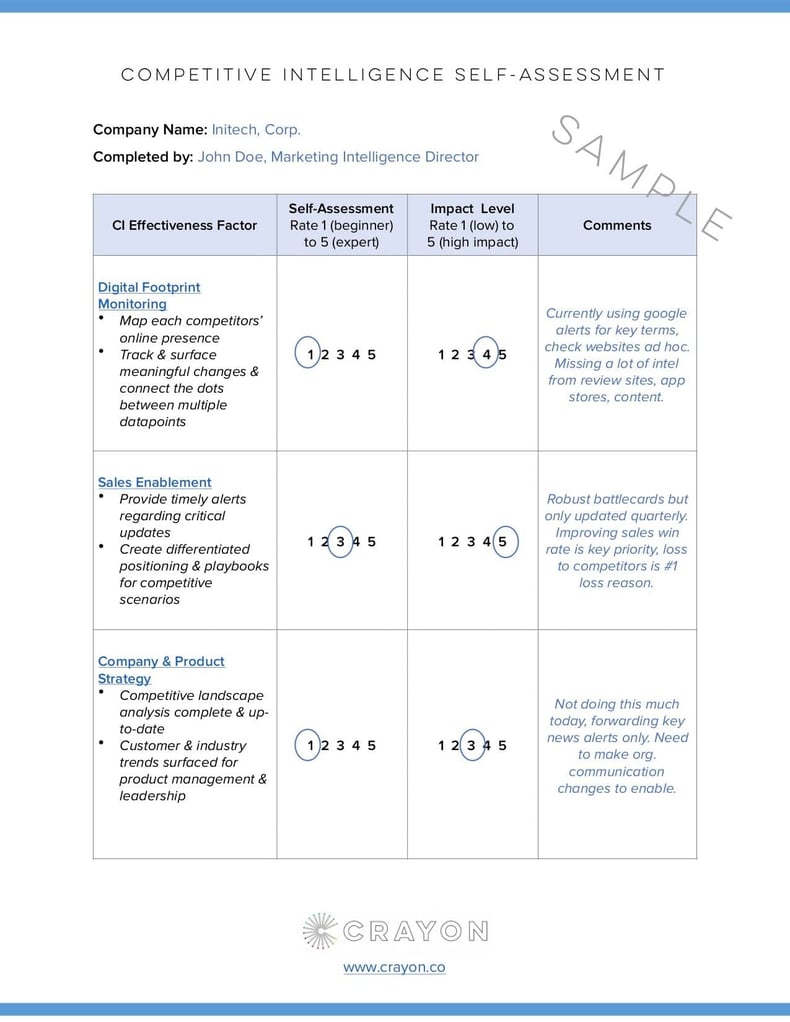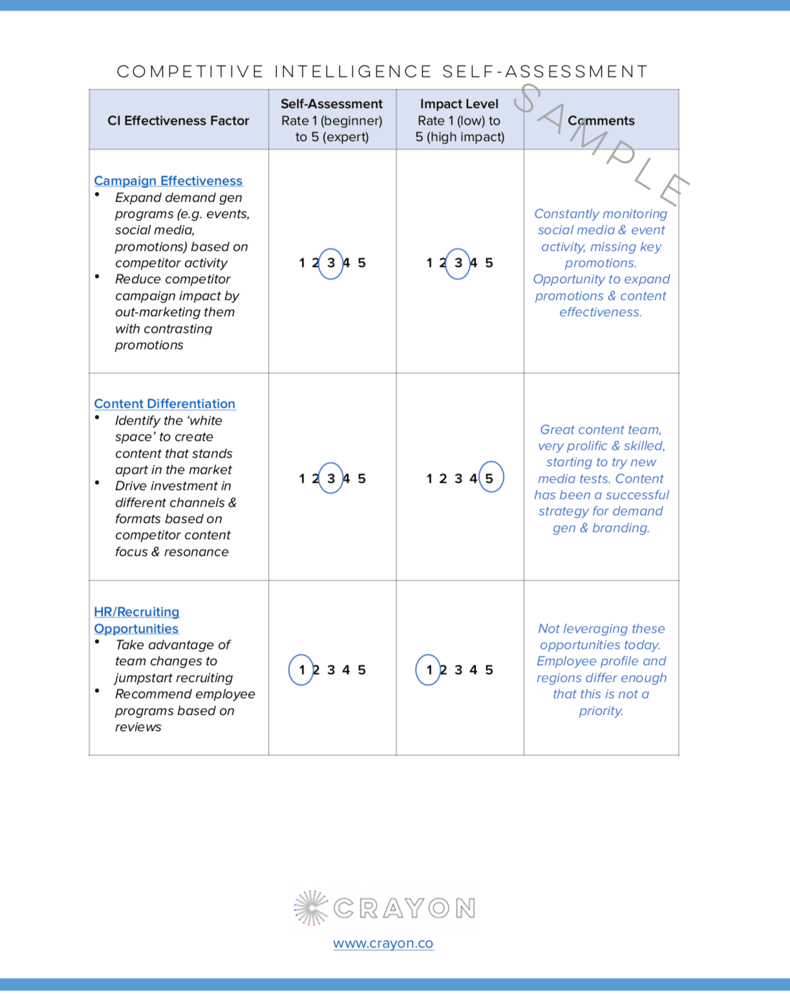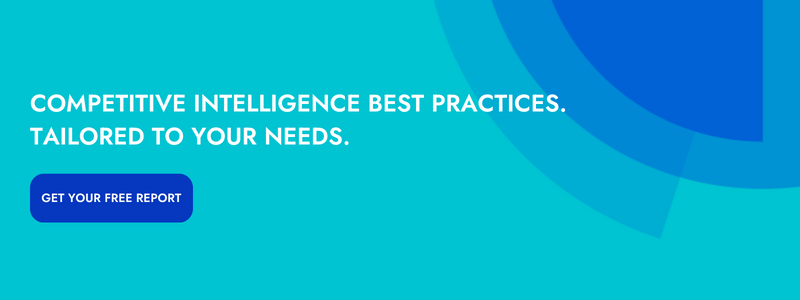Competitive intelligence (CI) surfaces insights that can - and should - be leveraged across the business. Competitive intelligence can be translated into tactical activities as well as strategic decisions by every department and every employee. Let’s walk through the key areas across the business where competitive intelligence actions can be most impactful and provide a framework for assessing your organization’s ability to take advantage of these opportunities.
5 Ways to Drive Success with Competitive Intelligence
There are five key ways effective teams use competitive intelligence to drive success across their organizations:
- Sales Enablement - supporting your sales team to win more competitive deals
- Product Strategy - developing differentiated products that serve the market’s needs
- Marketing Campaign Effectiveness - creating campaigns that stand out from competitors’ activities
- Content Differentiation - crafting content that covers unique topics, channels, or promotions
- HR/Recruiting Opportunities - enabling your business to attract and retain talent in a competitive market
Sales Enablement
CI enables your sales team to win more competitive deals, and a strong CI program enables you to be more proactive with those valuable competitive resources. In particular, a strong CI program allows you to create proactive competitive playbooks and provide responses to the latest market changes ahead of sales questions.
There are three ways you can translate competitive intelligence into actionable sales enablement resources:
- Competitive Alerts: Provide timely alerts regarding critical updates, with guidelines for response
- Competitive Battlecards & Playbooks: Create differentiated positioning and playbooks for competitive scenarios
- Market Data: Share the latest market data and competitive trends to more successfully adjust to market changes
Complete competitive intelligence data - from competitors’ product details to customer reviews to executive team changes - are critical for creating effective sales enablement resources.
Product Strategy
CI is also a key input for developing an effective product strategy, in particular, guiding product decisions to build and launch differentiated products. An effective CI program will include analyzing the competitive landscape to stay on top of market trends to inform product and overall company strategies.
There are three ways you can translate competitive intelligence into actionable product strategy resources:
- Product Comparisons: Benchmark competitor strengths and weaknesses to identify opportunities to create valuable solutions
- Positioning & Focus: Evaluate competitor focus and direction, and chart a differentiated course
- Customer Trends: Drive product development based on customer feedback to serve persona needs
Both a competitor’s public messaging about their products and the competitor’s customer feedback posted via review sites are critical inputs to putting together this product strategy picture.
Marketing Campaign Effectiveness
Marketing teams are key consumers of competitive intelligence because a strong CI program will provide great input on how to design and launch effective campaigns. In particular, CI can spark new campaign ideas based on competitors’ successes and investments, surfacing timely marketing opportunities.
There are three ways you can translate competitive intelligence into actionable marketing campaign resources:
- Content, Social, & PR: Find channels, mediums, and topics that drive success, providing input on which strategies to test or expand
- Tradeshows & Events: Identify events to join or sponsor, and prepare representatives attending competitive events
- Landing Pages & Promotions: Launch tests and promotions to drown out competitor campaigns, and leverage lessons learned by competitors’ tests
Be sure to gather competitive intelligence from a competitor’s every marketing channel - their website, their content platforms and social media accounts, their PR activities, and any other relevant channel.
Content Differentiation
In addition to influencing marketing campaigns, competitive intelligence has the power to inform content marketing strategies. By analyzing competitors’ content activities, you can identify the ‘white space’ in your market to create content that stands out, whether by topic, channel, or format.
There are three ways you can translate competitive intelligence into actionable content marketing resources:
- Unique Stories: Differentiate through different content topics, PR pitches, or company branding
- Unique Channels: Differentiate through under-used content mediums and channels to reach customers in new ways
- Unique Promotions: Differentiate through a novel approach to offers and promotions
A competitor’s content marketing extends all across their website and beyond their website as well. Be sure to analyze their content marketing across their entire digital footprint.
HR/Recruiting Opportunities
Finally, an often overlooked audience for competitive intelligence is HR. But CI has the ability to surface HR and recruiting opportunities to help a company scale ahead of competitors. To surface these opportunities, analyze HR signals from competitors’ employee feedback and news.
There are three ways you can translate competitive intelligence into actionable HR resources:
- Recruiting Competitors: Take advantage of competitor layoffs and office closings to recruit candidates
- Employer Branding: Benchmark employee reviews and qualitative feedback to build a company brand
- HR Programs: Drive employee programs based on top focus areas among industry workers
When you analyze competitive data such as executive leadership changes, hiring trends, and employee reviews, put on your HR hat from time to time to uncover these HR opportunities.
The One Prerequisite to Enable All Teams with Actionable CI
The wide range of CI resources noted here underscores the wide-reaching impact CI can have, but also the wide-ranging intelligence data required. A competitor’s digital footprint is giant, and only getting bigger as both businesses and consumers are more active online. To get a 360-degree view of your competitors’ strategies, you will need a 360 view of their activities.
Your CI Self-Assessment: Evaluate Your Effectiveness Across These 5 Dimensions
Now it’s time for your self-assessment. Outlined above are the five dimensions to evaluate against your current CI program. Where are you in terms of effectively tackling each of these CI program components? Are you just getting started with setting up alerts for your sales team, or do you have dynamic battlecards with the latest news and messaging? Are you just getting started with reviewing your competitors’ blog content, or do you have a full index and analysis of their content published across all platforms? Rate your current progress in each of these five areas.
But the self-assessment doesn’t end there, because each of these areas can carry a different level of importance for your business based on the industry or even the business’s current priorities. So the next step is to rate the (potential or realized) impact level of mastering each of these areas. What is the potential impact of mastering your competitive sales enablement? What is the potential impact of informing smart product decisions based on market changes?
It is the intersection of these two areas that provides the true insight for your business - what are the areas that can provide the greatest impact to your organization, and which of those areas require more or less investment. Use this self-assessment to guide your internal discussion about how best to have an impact with your CI efforts.



Related Blog Posts
Popular Posts
-
 How to Create a Competitive Matrix (Step-by-Step Guide With Examples + Free Templates)
How to Create a Competitive Matrix (Step-by-Step Guide With Examples + Free Templates)
-
 The 8 Free Market Research Tools and Resources You Need to Know
The 8 Free Market Research Tools and Resources You Need to Know
-
 Sales Battlecards 101: How to Help Your Sellers Leave the Competition In the Dust
Sales Battlecards 101: How to Help Your Sellers Leave the Competition In the Dust
-
 6 Competitive Advantage Examples From the Real World
6 Competitive Advantage Examples From the Real World
-
 How to Measure Product Launch Success: 12 KPIs You Should Be Tracking
How to Measure Product Launch Success: 12 KPIs You Should Be Tracking






